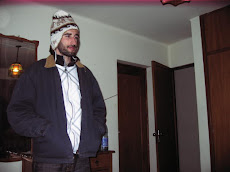** BREAKING NEWS UPDATE ***
Looks like I jinxed us with the detail about our impending departure to Argentina. The borders have closed due to snow, so we´re stuck here til at least Sunday. The Disneyesque atmosphere and warm days look more appealing now ... and maybe now we´ll get to go on the famous Star Tour (celestial, not celebrity). Violent dust storms cancelled the tour on our previous two attempts ... figures we´d hit the 27 days per year that clear San Pedro has partially cloudy skies.
SAN PEDRO DE ATACAMA, Chile -- When we crossed the frontier from Bolivia, I didn´t expect major changes in our surroundings. Three days into a trip over the desolate salt flats, we had gone from the middle of nowhere in one country to the middle of nowhere in another country. We would trade the high-altitude salt flats and Salvador Dali desert for the lower, warmer Atacama desert of northern Chile. We would enjoy the trip, but with no major difference in accomodations or infrastructure, I assumed.
But we were about to leave the poorest nation on the continent for the richest, and the difference became starkly apparent the minute we crossed the border.
Our intrepid tour guides dropped us off in the Land Cruiser at Bolivian border control, a concrete box with the national flag and a yellow and black gate over the dirt road. A rusted-out school bus, sans wheels or windows, lay a few yards away. We got our stamps, hopped on a new-looking bus that resembled the Park-n-Ride shuttle at the Fort Lauderdale airport, and passed through the gate. The driver handed us Chilean customs declarations (something else Bolivia never asked us for).
¨If you have any fruit, vegetables, animal items, coca leaves or other drugs, you have an hour to consume them,¨ he said. ¨Otherwise you have to pay a fine if they find them at customs.¨
He had put us on notice: we were about to reenter the First World.
We passed a sign with the Chilean flag, and the dirt road turned to asphalt. We had not seen asphalt on a highway since La Paz. It was new asphalt too, smooth stuff, apparently the result of the Mercosur agreement among South American nations. Then we saw signs next to the highway, telling us that this was the way to San Pedro, and that we shouldn´t drive faster than 60 km/h. I don`t know what was more distracting -- the reintroduction to traffic laws or the stunning scenery as we rapidly descended more than 2000 meters from the altiplano to the vast brown and red desert below, volcanoes looming on the horizon and salt glistening all around.
In San Pedro, customs searched our bags as promised. We left the highway for the dirt roads of the town -- but they were different from the rocky roads we had become accustomed to in Bolivia. They were like roads in a manufactured, high-class resort in Arizona or Utah. Someone took care of these smooth roads, which saw little traffic, and someone made sure that all the buildings conformed to a desert-town adobe code, with desert-style signage (I hate that bureaucratic word). And, to our incredible luck, the hotels, restaurants and stores all took Visa. The one problem -- a malfunctioning Visa ATM, was quickly solved. The people of San Pedro expected it to be solved, and it was. This transition gave us a bit of a culture shock. Still used to things never, ever getting done according to plan in Bolivia, we were prepared to do what we had to in order to get money. We had nearly reached the bus station to buy tickets to the next bigger town over when the ATM technician appeared.
It was nice, but a bit expensive, and a bit unsettling in a Disney kind of way. We head to Argentina today, hoping for a happy medium.
Friday, June 27, 2008
Subscribe to:
Post Comments (Atom)


No comments:
Post a Comment